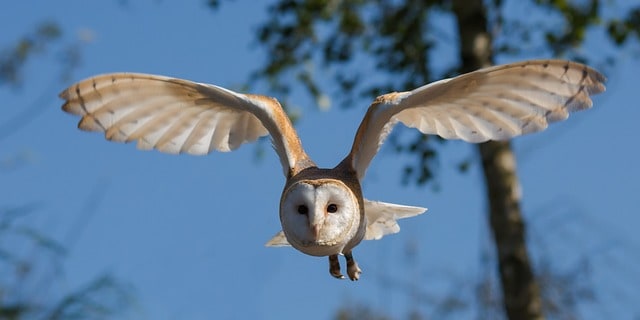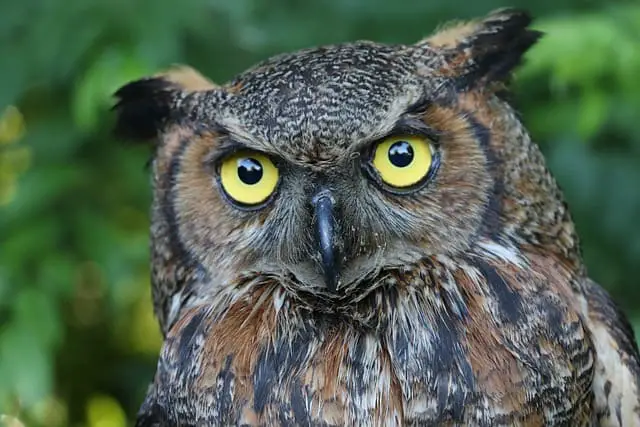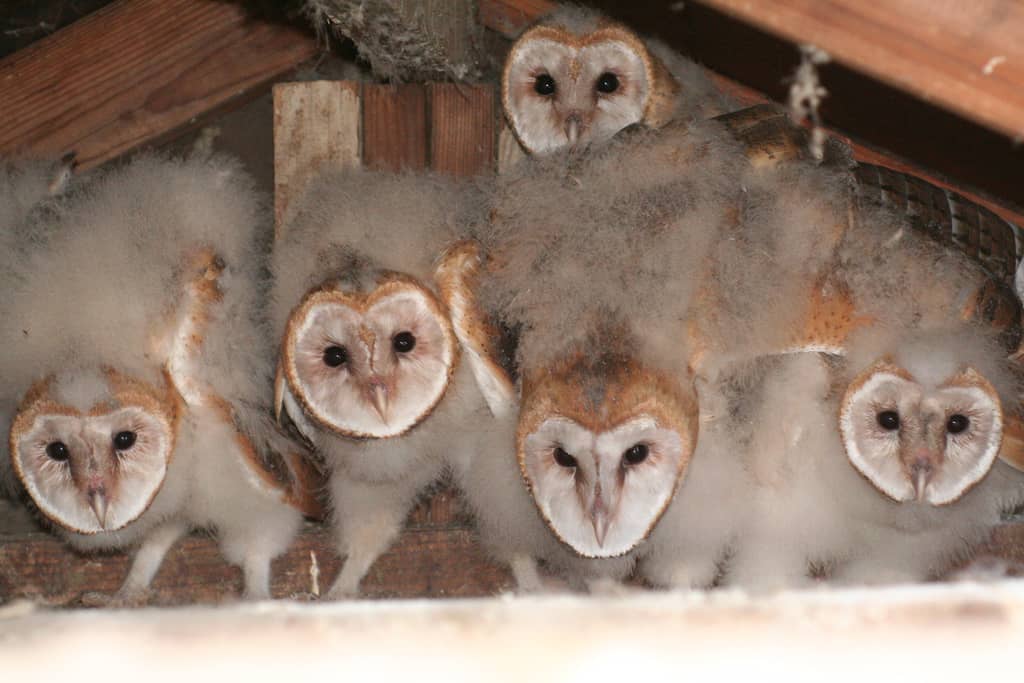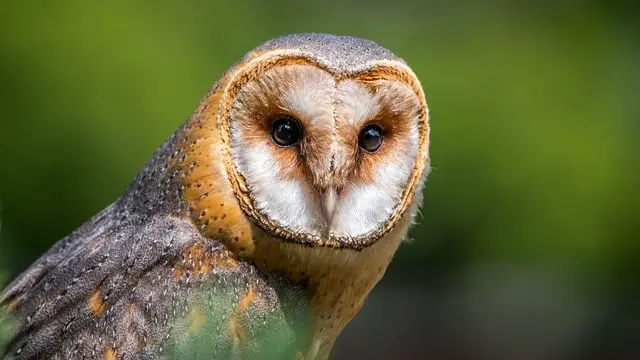Barn owls (Tyto alba) are the most widely distributed species of owls in the world. The polar and desert areas of the earth are the only places they don’t inhabit. What’s more, the only continent on earth that doesn’t have barn owls is Antarctica. Worldwide barn owl populations are currently between four million and ten million birds.
Some examples of diurnal owls that live in North America are the northern pygmy owl, the burrowing owl, and the northern hawk owls. The barn owl is not one of these.
- Like the great horned owl, barn owls live up to the night owl designation. They are predominantly nocturnal owls over most of their range. They spend their daylight hours in roosting sites that include hollow trees, crevasses in cliff ledges, riverbank burrows, and manmade structures such as barn lofts. However, in Great Britain and on some Pacific Islands and possibly in other areas, they also hunt in the daylight hours.
- Although a barn owl feeds primarily from dusk to dawn, food availability or the lack thereof dictates their hunting patterns. There are certain extenuating circumstances that have been shown to force barn owls to hunt during the day.
- One possible reason that barn owls might opt to change their sleep schedules and come out and hunt during daylight hours is if it was rainy the night before. They have soft fluffy feathers that are perfect for silent flight and ambushing prey from above. However, their feathers also tend to collect water. Consequently, on rainy nights barn owls usually don’t go out hunting.
- High winds on the previous night might also be a cause for barn owls to hunt during the day.
- Deep snow is another factor that might make barn owls come out and hunt during the day. When the snow is deep, it gives rodent populations extra cover, making their food supply harder to come by. Consequently, these nocturnal birds need to hunt longer hours to survive. They generally fly low over the terrain until they detect a rodent under the snow with their exceptional hearing. Then they plunge headfirst into the snow and attempt to capture the animal in their beak. Cold winters and crusted snow make this an even more difficult feat.
- One more thing that might force barn owls to hunt during the day is the day’s length in the northern latitudes. For example, in southern Sweden in June, the barn owls living there have up to 18 hours of daylight. There’s a possibility that they have to keep hunting during daylight hours to find sufficient food.
The possibility of being mobbed by birds such as blackbirds or crows keeps barn owls from doing more daylight hunting.
The barn owl specializes in hunting small mammals on the ground, such as field mice and meadow voles. In fact, more than 90% of a barn owl’s diet consists of small mammals. Consequently, open fields and any other open habitats make good hunting grounds for them. However, although they specialize in killing small rodents, their prey items also include small birds, reptiles, and amphibians.

Barn owl description
The Barn owl is a beautiful owl in shape and coloration. They are medium-sized owls with pale coloring, comparatively long wings, and a square, short tail. There is variation in size between the different sub-species, but an average body length for an adult barn owl is 13 to 15 inches, with a wingspan from 31 to 37 inches. In weight, they vary from a little under a pound to almost a pound and a half.
Barn owls display sexual dimorphism in size, with female barn owls being larger than males.
A barn owl’s head and back range from brown to dark grey in color. On the other hand, their facial disk, chest, and legs are white.
It’s difficult to visually distinguish between a male and female barn owl. However, there are some subtle distinctions. The first thing is that the facial disk on a female is rimmed with reddish brown. What’s more, females have darker bars on their tails and small black spots on their chests. On the other hand, males are purer white underneath.
Barn owl adaptations
These birds of prey have a very acute sense of hearing which they use to pinpoint their prey by sound. In fact, experiments have shown that they can capture their prey in complete darkness, using their sense of hearing without any help from their sense of sight. See
Barn owls have some interesting adaptations that enhance their ability to hear. First of all, the feathers in their facial discs capture and direct minute sound waves to their ears. What’s more, their ears which are located just behind their eyes, are placed asymmetrically, with the left ear being slightly lower than the right. This allows each ear to process sound waves independently and further zero in on any unseen prey.
Although this nocturnal predator has the ability to find small animals in total darkness, using only their sense of hearing, they also have excellent vision in low light levels. In fact, their eyes are about twice as light-sensitive as human’s.
They use their eyes to detect any slightest movement from small animals on the ground. They notice anything that moves instantly while disregarding inanimate objects. After they’ve zeroed in on moving prey, they swoop down and kill it with their sharp talons.
They have proportionately long legs. This helps them to reach down through deep vegetation if they need to.
After catching it, they generally swallow their prey animal whole and headfirst.


Barn Owls vs. True Owls
There are 2 families of owls in the world. These are true owls or typical owls and barn owls. Out of around 250 owl species in the world, 16 of them are barn owls.
One of the main distinctions between the two is in the facial disk. Barn owls have a heart-shaped face. They have large eyes like all owl species. However, unlike true owls, they have dark eyes. What’s more, they don’t have ear tufts or plumicorns.
On the other hand, true owls, such as great horned owls and snowy owls, have round facial disks, yellow or orange eyes, and plumicorns.

Barn owl mating behavior
Although barn owls do not defend a particular territory, they do live within a home range inside which they hunt for food. The size of their home range corresponds directly to the population density of their prey animals.
Male and female home ranges chiefly correspond with that of their mates. However, except during the breeding season, males and females mainly roost separately. Each bird has a favorite roost site in around 3 different areas. They conceal themselves in these during the day and may also briefly visit them in the night. When it gets closer to the breeding season, a mated pair of barn owls will move back to the vicinity of their chosen nest site to roost. They tend to be monogamous most of the time and generally mate for life.
Nesting season for barn owls that live in tropical regions might come at any time of year. However, in areas where there are distinct wet and dry seasons, egg-laying generally takes place during the dry season. This is because the lush vegetation which is present during the wet season makes it more difficult for them to find sufficient food to take care of their fledgling’s nutritional needs. After the vegetation dries back, hunting and locating prey becomes easier for them.
In North America and Europe, breeding season for barn owls runs from early spring, usually March through June, when temperatures are increasing. However, actual nesting dates vary from year to year. The deciding factor is the amount of available prey animals in the area surrounding their selected nesting site.
Barn owls prefer to nest in holes in hollow trees, cracks in cliff faces, or large abandoned nests of other birds. They also nest in man-made structures such as church steeples, hay sheds, or old barns. This is how they have earned their name, after all. Their nests are usually placed higher in the United States and Canada than in Europe. Ornithologists believe that this is due to the potential for nests being raided by raccoons.
In woodland habitat, barn owls generally seek out a lone tree to nest in rather than nesting in the deeper forest. Their preferred habitat must include some open country, such as agricultural fields. It’s simpler for them to locate their prey in such areas.
An increase in the local rodent population will induce them to start nesting. In fact, in years when the rodent population is particularly abundant, they may raise two broods. This even goes for barn owl pairs in the more northerly latitudes within their range where the weather is cooler.
For a period of time, before she starts laying eggs, the female remains near the nest. At this time, the male provides all of her food. When she reaches her peak weight, breeding begins, and she also begins to lay her eggs. She lines her nest with the fur from her regurgitated pellets. (Owl pellets are made up of the material from a prey animal such as fur, bones, and teeth that is undigestible.) An average clutch size is around five eggs.
Barn owl eggs take about thirty days to incubate. However, their incubation period is a prolonged process. It begins right after the female lays the first egg. However, egg laying might stretch out for several weeks. Consequently, the youngest barn owlet may be several weeks younger than the oldest.
The male barn owl continues in his important role as he continues to provide all the food until all the chicks are at least four weeks old. After that, the female begins to leave the nest and will participate in bringing food to her chicks. She’ll also spend longer and longer periods roosting away from the nesting site.
The young owls are still dependent upon their parents until they are around thirteen weeks old.
Recent Posts
The only venomous snakes in Washington State are Northern Pacific Rattlesnakes. The Northern Pacific Rattlesnake (Crotalus oreganus oreganus) is a sub-species of the Western Rattlesnake. Anyone...
Skunks are not classified as true hibernators. But they go into a state of torpor when the weather gets cold. Skunks are light sleep hibernators, along with opossums, bears, and raccoons. ...

